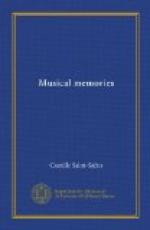As I have spoken of Richard Wagner’s youth, I will take advantage of the opportunity to reveal a secret of one of his own works which is known to me alone. When Wagner was young, I was a child and I attended constantly the sessions of the Societe des Concerts. The kettledrummer of that day had a peculiar habit of breaking in before the rest of the orchestra. When the others began, it produced an effect which the authors had hardly foreseen and which was certain to be condemned. But the effect had a rather distinctive character and I thought it might be possible to use it. Richard Wagner lived in Paris at the time and frequented the famous concerts. There is no doubt that he noted this effect and used it in his overture to Faust.
CHAPTER VII
ART FOR ART’S SAKE
What is Art?
Art is a mystery—something which responds to a special sense, peculiar to the human race. This is ordinarily called the esthetic sense, but that is an inexact term, for esthetic sense signifies a sense of the beautiful and what is esthetic is not necessarily beautiful. Sense of style would be better.
Some of the savage races have this sense of style, for their arms and utensils show a remarkable feeling for style, which they lose by contact with civilization.
By art let us understand, if you please, the Fine Arts alone, but including decorative art. Music ought to be included.
I shall astonish most of my readers, when I say that very few people understand music. For most people it is, as Victor Hugo said, an exhalation of art—something for the ear as perfume is for the olfactory sense, a source of vague sensations, necessarily unformed as all sensations are. But musical art is something entirely different. It has line, modeling, color through instrumentation, all making up an ideal sphere where some, like the writer of these lines, live from childhood on, which others attain through education, while many others never know it at all. Furthermore, musical art has more movement than the other fine arts. It is the most mysterious of them all, although the others are mysterious as it is easy to see.
The first manifestation of art occurs through attempts to reproduce objects. Such attempts have been found which date back to prehistoric times. But what is primitive man’s idea in such attempts? He wants to record by a line the contour of the object, the likeness of which he wishes to preserve. This contour and this line do not exist in nature. The whole philosophy of art is in that crude drawing. It bases itself on nature even while making something quite different in response to a special, inexplicable need of the human spirit. Accordingly nothing can be more chimerical or vain than the advice so often given to the artist to be truthful. Art can never be true, even though it should not be false. It should be true artistically, by giving an artistic




